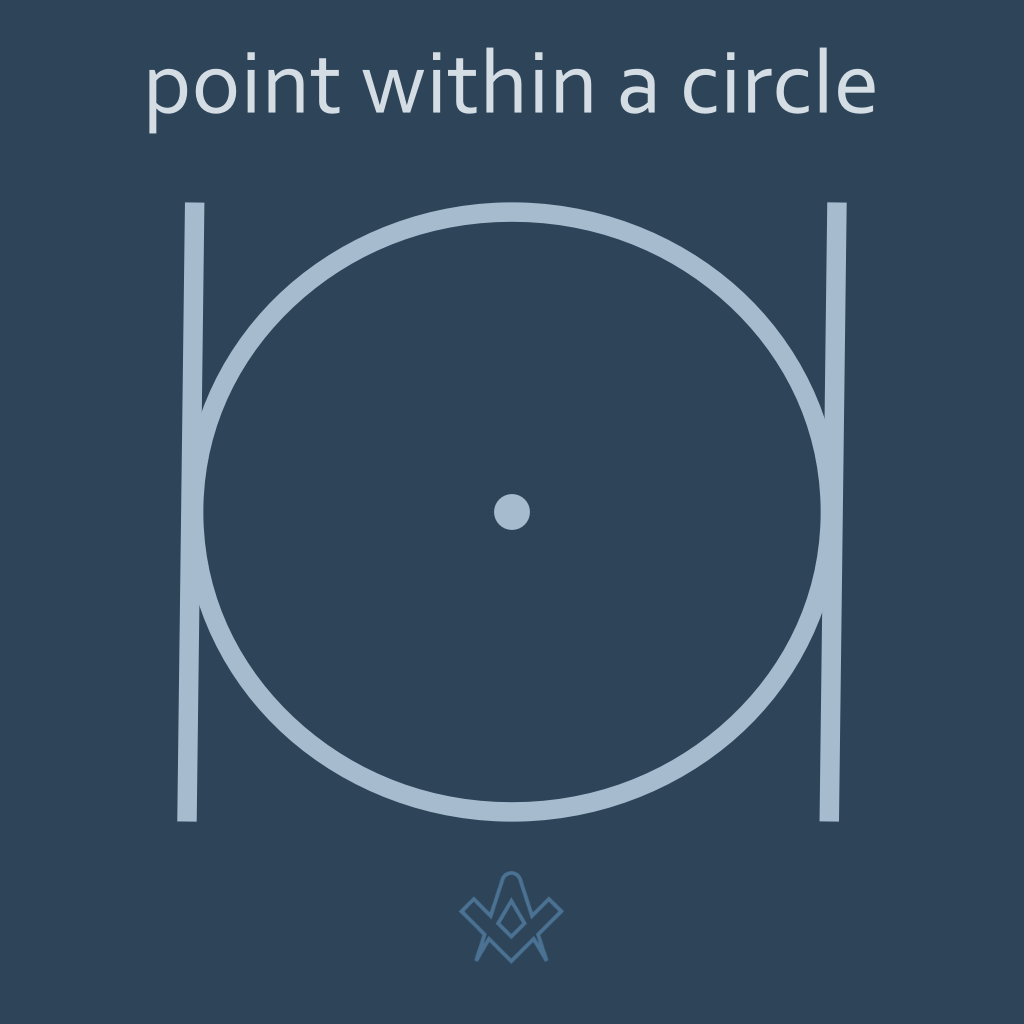There is in every regular and well-governed Lodge, a certain point within a circle, embordered by two perpendicular parallel lines….
It is among the most illuminating of the Entered Apprentice’s symbols and is important not only for its antiquity, and many meanings which have been read from it, but because of the bond it makes between the old operative stone setter’s art and the Speculative Masonry we know.
No man may say when, where, or how the symbol began. From the earliest dawn of history a simple closed figure has been man’s symbol for Deity – the circle for some peoples, the triangle for others, and a circle or a triangle with a central point for still others.
In some jurisdictions a lodge closes with brethren forming a circle about the altar, which thus becomes the point or focus of the Supreme Blessing upon the brethren.
A symbol may have many meanings, all of them right, so long as they are not self- contradictory. As the point within a circle has had so many different meanings to so many different people, it is natural that it have many meanings for Freemasons.
It is connected with sun worship, the most ancient of religions; ruins of ancient temples devoted both to sun and to fire worship are circular in form with a central altar or point which was the Holy of Holies.
The symbol is found in India in which land of mystery and mysticism its antiquity is beyond calculation. In ancient meaning the point represents the sun and the circle the universe. This is both modern and ancient, as a dot in a small circle is the astronomical symbol for the sun.
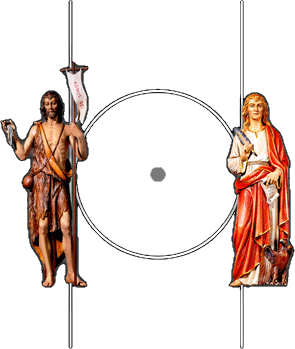
John the Baptist and John the Evangelist
IMAGE CREDIT: wikimedia Attribution 4.0 International (CC BY 4.0)
The two parallel lines which in modern Masonry represent the two holy Saint Johns are as ancient as the rest of the symbol, but originally had nothing to do with the “two eminent Christian patrons of Masonry.“
They date back to an era before Solomon. On early Egyptian monuments may be found the Alpha and Omega or symbol of God in the centre of a circle embordered by two perpendicular, parallel serpents representing the Power and the Wisdom of the Creator.
This is not only a symbol of creation but is fraught with other meanings. When man conceived that fire, water, the sun, the moon, the stars, the lightning, the thunder, the mountains and rivers did not each have a special deity, that in all this universe there was but one God, and wanted to draw a picture of that conception of unity, the only thing he could do was to make a point.
When man conceived that God was eternal, without beginning and without ending, from everlasting to everlasting, and desired to draw a picture of that conception of eternity, he could but draw a circle that goes around and around forever.
When man conceived that the Master Builder did not blow hot and cold, that he was not changing, fickle and capricious, but a God of rectitude and justice, and needed to picture that conception of righteousness, he drew straight up and down parallel lines. So this symbol stands for the unity, the eternal life, and the righteousness of God.
That derivation of the symbol which best satisfies the mind as to logic and appropriateness students find in the operative craft.
The tools used by the cathedral builders were the same as ours to-day; they had gavel and mallet, setting maul and hammer, chisel and trowel, plumb and square, level and twenty-four inch gauge to “measure and lay out their work.”
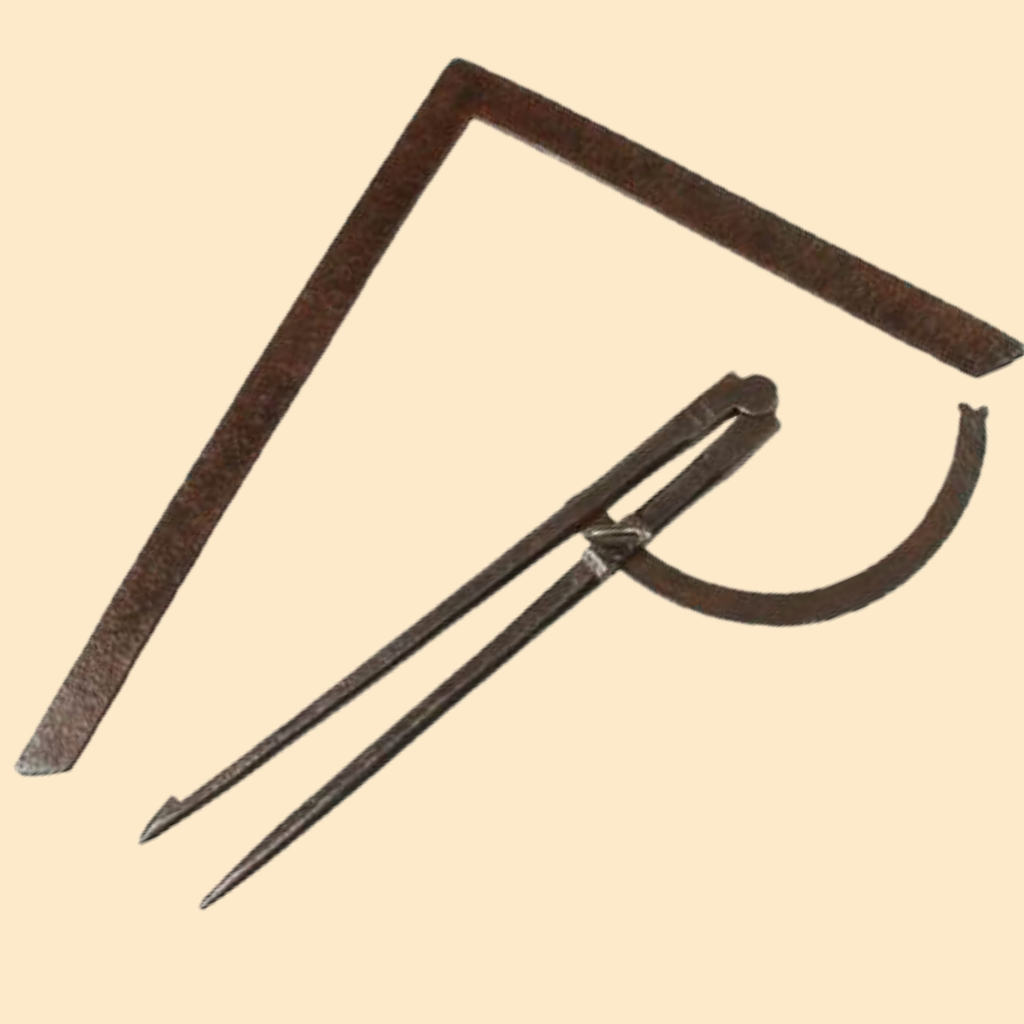
Stonemason’s square and compasses
IMAGE CREDIT: wikimedia Attribution 4.0 International (CC BY 4.0)
The square, the level, and the plumb were made of wood – wood, cord, and weight for plumb and level; wood alone for square.
Wood wears when used against stone and warps when exposed to water or damp air. The metal used to fasten the two arms of the square together would rust and perhaps bend or break. Naturally the squares would not stay square indefinitely but had to be checked up constantly for their right-angledness.
The importance of the perfect right angle in the square by which the stones were shaped can hardly be overestimated. Operative Masonry in the cathedral-building days was largely a matter of cut and try, of individual workmen, of careful craftsmanship.
Quantity production, micrometre measurement, interchangeable parts had not been invented. All the more necessary then that the foundation on which all the work was done should be as perfect as the Masters knew how to make it.
Cathedral builders erected their temples for all time – how well they built a hundred glorious structures in the Old World testify. They built well because they knew how to check and try their squares.

Thales of Miletus c624/623 – c548/545 BC
IMAGE LINKED: wikimedia Attribution 4.0 International (CC BY 4.0)
Thales of Miletus was a Greek mathematician, astronomer and pre-Socratic philosopher from Miletus in Ionia, Asia Minor. He was one of the Seven Sages of Greece.
Many, most notably Aristotle, regarded him as the first philosopher in the Greek tradition and he is otherwise historically recognized as the first individual in Western civilization known to have entertained and engaged in scientific philosophy.
In mathematics, Thales used geometry to calculate the heights of pyramids and the distance of ships from the shore.
He is the first known individual to use deductive reasoning applied to geometry, by deriving four corollaries to Thales’ theorem. He is the first known individual to whom a mathematical discovery has been attributed.
YouTube Video ( 6 mins ) by ScienceOnline
Draw a circle – any size – on a piece of paper. With a straight edge draw a line through its centre. Put a dot on the circumference anywhere.
Connect that dot with the line at both points where it crosses the circle. Result, a perfect right angle.
This was the operative Master’s great secret – knowing how to “try the square.”
It was by this means that be tested working tools; did he do so often enough it was impossible either for tools or work “to materially err.“
From this also comes the ritual used in the lodges of our English brethren where they “open on the center.“

The original line across the centre bas been shifted to the side and become the “two perpendicular parallel lines” of Egypt and India, and our admonitions are no longer what they must once have been; … “while a Mason circumscribes his square within these points, it is impossible that it should materially err.”
But how much greater becomes the meaning of the symbol when we see it as a direct descent from an operative practice! Our ancient brethren used the point within a circle as a test for the rectitude of the tools by which they squared their work and built their temporal buildings.
In the Speculative sense we use it as a test for the rectitude of our intentions and our conduct, by which we square our actions with the square of virtue. They erected Cathedrals – we build the house not made with bands.
Their point within a circle was operative – ours is Speculative. But through the two – point in a circle on the ground by which an operative Master secretly tested the squares of his fellows – point within a circle as a symbol by which each of us may test, secretly, the square of his virtue by which he erects an Inner Temple to the Most High – both are Masonic, both are beautiful.
The one we know is far more lovely that it is a direct descendant of an operative practice the use of which produced the good work, true work, square work of the Master Masons of the days that came not back.
Pass it not lightly. Regard it with the reverence it deserves, for surely it is one of the greatest teachings of Masonry, concealed within a symbol which is plain for any man to read so be it he has Masonry in his heart.
Article by: Carl H. Claudy
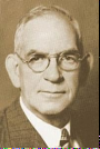
Carl Harry Claudy (1879 – 1957) was an American author, magazine writer, and journalist for the New York Herald.
His association with Freemasonry began in 1908, when, at the age of 29, he was raised a master Mason in lodge Harmony No. 17 in Washington, DC. He served as its master in 1932 and eventually served as Grand Master of Masons in the District of Colombia in 1943.
His Masonic writing career began in earnest when he became associated with the Masonic service Association in 1923, serving as associate editor of its magazine, The master mason, until 1931.
Under his leadership the service Association was brought to a place of predominance through his authorship and distribution of the short talk bulletin which made his name familiar to virtually every lodge in the country.
 Old Tiler Talks - Eyes Lifted High The Old Tiler Talks first published in 1925, by Carl Claudy, is a series of short anecdotal stories told in the setting of a new member asking an old tiler for his opinion on various masonic topics. These short articles are still very relevant, 100 years on, and hopefully provide some insight to new members today. |
 Old Tiler Talks - Masonic Libraries The Old Tilers talks first published in 1925, by Carl Claudy, is a series of short anecdotal stories told in the setting of a new member asking an old tiler for his opinion on various masonic topics. These short articles are still very relevant, 100 years on, and hopefully provide some insight to new members today. |
 Old Tiler Talks - So Many Rascals "Why are there so many rascals in the Fraternity, and why don't we turn them out?" a new member voiced to the old tiler for his opinion. These short articles are still very relevant, 100 years on, and hopefully provide some insight to new members today. |
 Old Tiler Talks - The Greatest Work The Old Tiler asked, "what is the greatest work of Masonry?" The New Brother sat by the guardian of the door and pulled out his cigar case. - Another instalment of wisdom by Carl Claudy, The Greatest Work |
 Old Tiler Talks - Why Men Love Freemasonry The 'Old Tiler Talks' first published in 1925, by Carl Claudy, is a series of short anecdotal stories told in the setting of a new member asking an old Tiler for his opinion on various Masonic topics. These short articles are still very relevant, 100 years on, and hopefully provide some insight to new members today. |
 Old Tiler Talks - Seeking a Little Light The Old Tilers talks first published in 1925, by Carl Claudy, is a series of short anecdotal stories told in the setting of a new member asking an old tiler for his opinion on various masonic topics. These short articles are still very relevant, 100 years on, and hopefully provide some insight to new members today. |
 The new mason laments that practically speaking, Masonry is a failure, and it depresses me … Masonry cannot be a failure, because men fail as Masons. The Old Tilers talk by Carl Claudy |
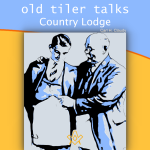 Old Tiler Talks - Country Lodge A lesson in the importance of an open mindset to observe, not to judge, but to learn and accept that we can achieve the desired outcome employing a different process. by Carl Claudy |
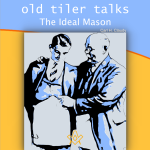 Old Tiler Talks - The Ideal Mason "What's your ideal of Freemasonry?" asked the Younger Mason - A short anecdotal story told in the setting of a new member asking an old tiler for his opinion on various masonic topics by Carl Claudy |
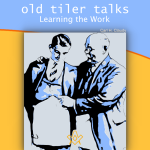 Old Tiler Talks - Learning the Work A short anecdotal story told in the setting of a new member asking an old tiler for his opinion on various masonic topics by Carl Claudy |
 Masonic first appointments and promotions might appear to be inequitable for one point a view, but some times, one point does not show the whole picture. A perfectly articulated story by Claudy, we should not compare one persons abilities with another. |
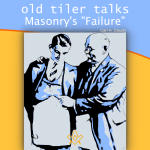 Old Tiler Talks - Masonry's 'Failure' Masonry fails because it doesn’t interest men sufficiently to make them practice what they preach. A perfectly articulated story by Claudy Masonry does not fail men. Men fail Masonry. Masonry has the teachings. |
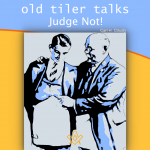 A perfectly articulated story by Claudy reminds us of a lesson from the Second Degree Charge; in the decision of every trespass against our rules, judge with candour, admonish with friendship, and reprehend with mercy. |
 Old Tiler Talks - A Masonic Speech A Masonic Speech - I can tell you the essence of appeal. It is drama. If you want your hearers to hang on your words, dramatize your subject |
 Old Tiler Talks - A Mason's Christmas A Mason's Christmas - Do you believe in Christmas celebrations should be held by the lodge ? Should members be asked to contribute to one and engage in Christmas festivities ? What is the old tilers take on this ? |
 Advertising - We would do more good in the world if we advertised ourselves more… Why ? |
 Uncover the mystery behind one of the oldest and most widespread symbols denoting God. |
 Do you want to discover the originals of the five points of fellowship ? |
 The mystery behind the two great pillars that stood at the porchway entrance of King Solomon Temple |
 Three numbers, what are their masonic significance? Pythagoras has something to say about them |
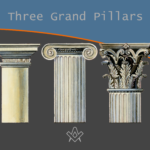 What are the Three Grand Pillars ?, wisdom, strength, and beauty - then later we hear of the Doric, Ionic, and Corinthian columns |
 This emblem contains more real food for thought than any other in the lecture of the Sublime Degree. |
 The Hiramic Legend is the glory of Freemasonry; the search for that which was lost is the glory of life |
 How are the Fellowcraft's five steps connected the five senses of human nature |
 How to explain the principle tents of the craft to a newly made brother |
 What are the lesser lights and where are they placed on our Lodges |
 Like so much else in Freemasonry the Middle Chamber is wholly symbolic |
 In the true sense of the words Freemasonry is not a secret society but a society with secrets. |
 Three Great Lights – the Volume of the Sacred Law, the Square, and the Compasses |
 Entered Apprentice Lambskin Apron; More ancient than the Golden Fleece or Roman Eagle, more honourable than the Star and Garter ... |
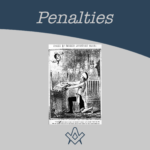 To the initiate, the penalty in his obligation comes with a shock of surprise and sometimes consternation. |
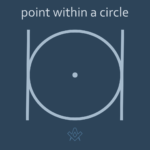 What is a point within a circle |
masonic knowledge
to be a better citizen of the world
share the square with two brothers

click image to open email app on mobile device


